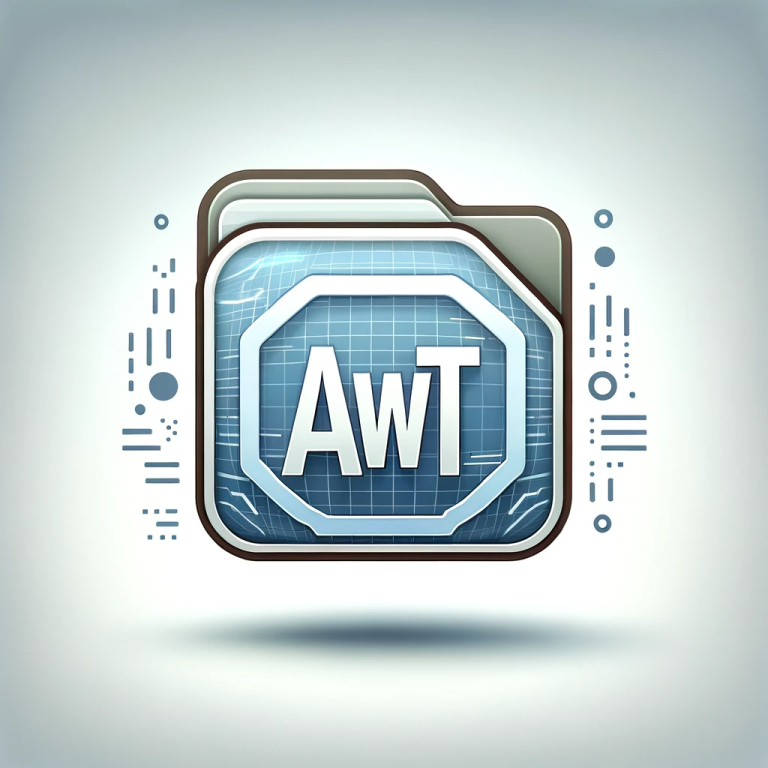.AWT File Extension

AbiWord Template
| Developer | AbiSource |
| Popularity | |
| Category | Text Files |
| Format | .AWT |
| Cross Platform | Update Soon |
What is an AWT file?
The .AWT file extension represents a type of text file that is commonly associated with certain applications and programming environments.
.AWT files typically contain textual information, code, or configuration data used by various software programs.
Understanding the origin, history, structure, advantages, disadvantages, and methods for opening and converting AWT files can be essential for users and developers alike.
More Information.
The .AWT file format has a long history dating back to the early days of Java. It was first introduced in JDK (Java Development Kit) 1.0, which was released in 1995.
.AWT aimed to provide a way for Java developers to create user interfaces that could run on various platforms without modification.
Java evolved, and newer libraries and frameworks, such as Swing and JavaFX, became more popular for GUI development. AWT files continue to exist, primarily in legacy code and projects.
Origin Of This File.
The .AWT file extension is closely related to the Java programming language. It stands for “Abstract Window Toolkit,” a core part of Java’s GUI (Graphical User Interface) library.
. AWT was introduced by Sun Microsystems, now owned by Oracle Corporation, as a way to create platform-independent graphical user interfaces in Java applications.
File Structure Technical Specification.
AWT files are typically plain text files that contain Java source code or configuration settings. They adhere to the syntax rules of the Java programming language.
The structure of these files can vary significantly based on their intended purpose, but they often include class definitions, method implementations, and event handling code related to graphical user interfaces.
How to Convert the File?
Windows:
- If the AWT code is written in Java, it can be easily reused in a Windows environment.
- No conversion is needed; just open the AWT file in a Windows-compatible text editor or integrated development environment (IDE) like Eclipse or IntelliJ IDEA.
Linux:
- Linux also supports Java, so AWT code written in Java can be used without conversion.
- Open the AWT file in a Linux-compatible text editor or IDE, such as Nano, Vim, Gedit, Eclipse, or IntelliJ IDEA.
Mac:
- MacOS supports Java as well, so Java-based AWT code can be used on a Mac without conversion.
- Open the AWT file in a Mac-compatible text editor or IDE, such as Nano, Vim, Gedit, Eclipse, or IntelliJ IDEA.
Android:
- Rewrite the AWT code in Java or Kotlin, the primary programming language for Android app development.
- Create a new Android project using Android Studio, the official IDE for Android development.
- Adapt the AWT code to work with Android’s UI components (e.g., TextView, Button) and layout system (e.g., XML-based layouts).
- Implement any additional Android-specific functionality as needed.
iOS:
- Rewrite the AWT code in Swift or Objective-C, the primary language for iOS app development.
- Create a new iOS project using Xcode, Apple’s official IDE for iOS development.
- Redesign the user interface using iOS-specific UI components (e.g., UILabel, UIButton) and layout tools (e.g., Interface Builder or programmatic Auto Layout).
- Implement any additional iOS-specific functionality as required.
Advantages And Disadvantages.
Advantages:
- Platform Independence: AWT files, being part of Java, can run on multiple platforms without modification.
- Familiar Syntax: Developers familiar with Java can work with AWT files using the same syntax and conventions.
- Integration: AWT files can be seamlessly integrated with Java applications, making it a suitable choice for older projects.
Disadvantages:
- Limited Functionality: AWT’s capabilities are relatively basic compared to more modern GUI libraries, such as Swing and JavaFX.
- Less Attractive User Interfaces: AWT interfaces may appear less visually appealing than those created with newer tools.
- Legacy Status: AWT is considered outdated, and its use is discouraged in favor of more advanced alternatives.
How to Open AWT?
Open In Windows
- You can open AWT files in a text editor such as Notepad, Visual Studio Code, or any code editor of your choice.
- For Java development, it’s recommended to use an IDE like Eclipse, IntelliJ IDEA, or NetBeans. Simply import the AWT file into your Java project.
Open In Linux
- Use a text editor like Nano, Vim, Gedit, or VSCode in a Linux terminal to view and edit AWT files.
- Install and use IDEs like Eclipse, IntelliJ IDEA, or NetBeans, which have Linux versions available. Import the AWT file into your Java project within the IDE.
Open In MAC
- Similar to Linux, you can use text editors like Nano, Vim, Gedit, or VSCode in the macOS terminal to open and edit AWT files.
- Mac supports popular Java IDEs like Eclipse, IntelliJ IDEA, and NetBeans. Install the Mac version of your preferred IDE and import the AWT file into your Java project.
Open In Android
- Rewrite AWT code in Java or Kotlin, Android’s primary programming languages.
- Utilize Android Studio to create an Android project, integrate the translated code, and redesign the user interface using Android-specific components.
Open In IOS
- Rewrite AWT code in Swift or Objective-C, the languages used for iOS development.
- Employ Xcode, Apple’s official IDE, to initiate an iOS project, incorporate the translated code, and redesign the user interface using iOS-specific components.
Open in Others
- Select the target programming language and framework compatible with the intended platform.
- Manually rewrite and adapt the AWT code, taking into account the platform’s requirements, and utilize the official development tools and IDEs for that platform to create and run your application.













